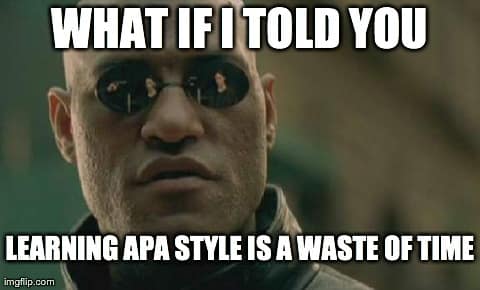
How to avoid learning APA style
One of the things that all psychology students learn is how to format a document in APA style. A quick Google search reveals many websites devoted partly or solely to helping people with their spacing, periods, and italics. Psychology journals require that authors adhere to the standard style when they submit papers. As a psychologist, I’ve submitted many such papers, but I have a confession to make. I do not own an APA manual. I never learned APA style.
Why is learning APA style a waste of time, especially in the 21st century? The simple answer is that format and style should be done by computer software! If you think about a book, manuscript, paper, or website — really, any document that contains information — there are two “parts” of the document. There is the information itself (the words), and then there’s the style in which that information is presented. The same information can be presented in many different styles, and a single style can be reused for many different purposes. Theoretically, if you can supply the proper information, computer software can give that content back to you in any style you like. This is in fact how much of the modern web works. I won’t get into the reasons why psychology journals still think it is 1950, but it has something to do with an evil piece of software called Microsoft Word. What I would like to tell you about is how you can avoid learning APA style by taking advantage of software that properly respects the difference between information and style. I’ll start by showing you how to avoid learning how to format APA citations. Theoretically, what we need is software that stores bibliographic information, formatting it in whatever style we want whenever we ask. There are several software packages that can do this. I personally use a software called Bibtex, but this can be difficult to use for the beginner. I will demonstrate how to use the Zotero software for managing your citations.
Zotero: a citation manager
Zotero is software that you install on your computer and helps you track your citations. Part of the software is a plugin for your browser that interfaces with databases like PsycInfo and JSTOR (or whatever databases you use) to enable saving bibliographic info and PDFs with a single mouse click. Another part helps you search and organize your citations, make notes, and, of course, create bibliographies.
Preliminaries
Before we learn how to use Zotero, we need to take care of some preliminaries.
- The first thing you need to do is install either Chrome or Firefox, assuming you don’t have one of them.
- Now install Zotero stand-alone.
- Next, install the Zotero plugin for your chosen browser (Chrome or Firefox).
- Finally, if you are using Firefox you can optionally install the Word or LibreOffice plugin to use Zotero with your word processor
Using Zotero
Once you’ve installed everything, start the stand-alone Zotero for the first time. You should see a window something like this:
You may have a few “example” entries in your Zotero already; you can leave them or delete them, as you like. Leave Zotero open and open up your browser. Go to PsycInfo (University of Groningen students and faculty can click here; others will have to go through their own university portal). Search for your favorite paper, or, if you don’t have one, search for “unskilled and unaware of it”.
If your search yields multiple hits, click on one of them to see its complete record. When you enter the record, your browser address bar should change to contain a paper-like icon; see the image below on the right, to the left of the star:
This icon indicates that Zotero can strip the information from this page, and add it you your database. If instead you see an icon that looks like a folder — for instance, on a search result page — this means that Zotero can save multiple records at a time for you. Click the icon, and Zotero will gather as much information as it can, and create an entry in your Zotero database. As it does, you may see a window like this:
Now move to your Zotero stand-alone program, and notice that an entry has been added for the article. All the information about that article is in your personal database.
If you were downloading this article as part of a research project, you could save the PDF in the record, add notes containing your thoughts about the article, add tags to help organize your references, and much more. Zotero is a great way to organize your own research projects. For the purposes of this blog, we are interested in obtaining an APA-formatted bibliography. Once the items are in your database, this is easy! For the purposes of demonstration, I added many items to my own database. To create a bibliography, select all the articles you want in the bibliography and right-click. Then, select “Create Bibliography from items…”
and you’ll get a new window allowing you to select a style. Select “American Psychological Association 6th edition”:
and then choose how you want to output them. Save yours to an HTML file, and then open the HTML file. The file should contain automatically formatted, APA-style references. The results of my output are below:
Interfacing with Word or LibreOffice
It is possible to use Zotero directly in Microsoft Word or LibreOffice. This is quite convenient, but is beyond the scope of this blog post (mostly because I think Microsoft Word is a terrible program and do not condone its use). However, the YouTube video below will show you how to use it. https://www.youtube.com/watch?v=aMkccKZ0Hio
Wrap-up
These days, there’s no reason to learn how to format APA citations, because there are many programs that will do it for you. Zotero is software that will allow you to store, organize, search, and create bibliographies from your stored citations. In addition to being convenient for creating bibliographies, software like Zotero is an important part of organizing your research. If you’d like to know more about using Zotero, there are many tutorials and screencasts on the Zotero website. Zotero is not the only software out there. Other possibilities, some of which are free, include:
- LaTeX/BiBTeX (tutorial), which will also format your whole document in APA style
- Mendelay
- EndNote
- Reference Manager
- RefWorks (used by the RUG)


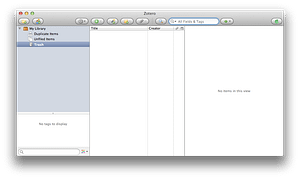

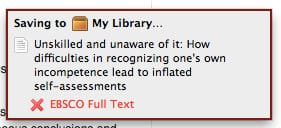
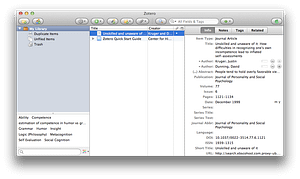
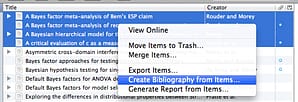
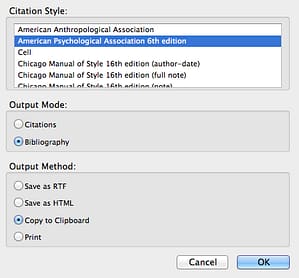



Also, there is this APA-6th-template for MS Word from the Microsoft webpage 😉
http://office.microsoft.com/en-us/templates/apa-style-report-6th-edition-TC103982351.aspx
Oh, but that’s just a template for the layout, Daniel. Zotero manages your citations and places them in the right format automatically.
-t
Does it get the in-text citations right? My experience with using CSL with pandoc (I understand CSL is what Zotero uses to define formatting) is that it gets a few things wrong (e.g., putting “&” rather than “and” between authors outside parentheses). This doesn’t bother me personally, but is the type of thing that unpredictably annoys reviewers.
I disagree that psychology students should not learn APA style because software is available to layout your text. With the same line of reasoning one can argue that children do not have to learn arithmetics because the calculator can do it for them. Moreover, APA style is much more than just a layout style. I promiss to write a more detailed reply on this soon.
I wholeheartedly recommend Zotero. I’m also unhappy with the emphasis that is put on the APA manual in our curriculum. It may be the mandatory style for publication in APA journals, but for any other purpose it is just atrocious. It is not a manual for clear and elegant writing. But maybe Yvonne will convince me.
Yvonne, APA style is nothing like arithmetic. Arithmetic is a set of algorithms for mathematical operations. APA style is a set of (mostly arbitrary) *standards*. The standards themselves are needed, of course, but there’s no reason why they have to be learned by students or scientists, who can make much better use of their time (preferably by learning statistics better :).
Simon, shouldn’t you be using LaTeX? 🙂 I’m not sure of the answer to your question about parenthetical citations; perhaps I’ll test it out and see. I do know that for a while, I was using the LaTeX APA bibtex style, and that was one thing that it messed up (before I switched to bibLaTeX). I never had a reviewer complain.
Actual student here. Thank your for the article!
Yvonne isn’t saying that APA style is like arithmetic, though. She’s saying that claiming students don’t need to learn APA style because reference managers exist is like claiming that kids don’t need to learn arithmetic because calculators exist, and it is. While reference managers help me with a small part of APA style, citations, it doesn’t help me with the oddly complex rules for, say, writing in-text numbers. I mean, I don’t disagree that APA style is unwieldy or that the ratio of “structuring your argument” to “formatting your paper” is off in our curriculum, but we still need to learn it.
Christian, I’m going to stick with the (perhaps crazy) assertion that if we live in a world where becoming a successful researcher depends on knowing whether to put a zero before the decimal, we should re-evaluate things. Luckily, it’s just another software problem.
Completely forgot about this, but I obviously agree we should restructure things. A lot of things. However, pointing out that things need restructuring is the domain of researchers, not students. Students should be taught what they need to function in the domain as it actually exists, in addition to being taught how to evaluate how optimal the structure of that domain is, not only one or the other. I agree that there is an excessive emphasis on the former to the exclusion of the latter, but let’s not throw the baby out with the bathwater.
I am not familiar with any software solution for the problem of APA formatting beyond very specific facets of it, such as citations. Zotero certainly doesn’t do this, nor does my own preference Mendeley, and I have difficulty seeing how, in principle, a software solution would be able to tell when I’ve written “9” instead of “nine.”